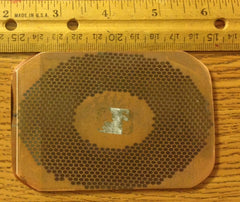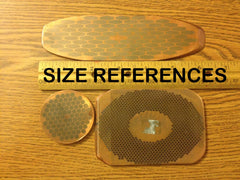







* EXTREMELY RARE PREMIUM raw metal alloy material (Honeycomb Elliptic pattern) for knife bolsters, jewelry, ornaments, etc... see pictures how to anodize it.
* Cut from the sample runs of the main conductor rods of the ex-Texas Superconducting Super Collider a.k.a Desertron that was started years ago. The project was scrapped due to budget cuts. (WIKI: https://en.wikipedia.org/wiki/Superconducting_Super_Collider).
* This is a piece of Titanium Niobium superconductor preform. It starts it's life as a huge copper block with hundreds of holes drilled into it. Into those holes Ti/Nb alloy rods are inserted. The whole block is then plasma welded in a vacuum until it's a solid billet, then it's taken to a drawing machine where it's slowly drawn down until it's 3/32" thick wire, which is wound into the magnetic coils for the containment magnets. This piece here would be what is considered "preform" or half made wire. It was drawn down to a little under 1/3 it's starting size before the whole SSC project was cancelled.
* Wire EDM cut. The item will be sent in un-polished condition.
* Shipped thru USPS Priority mail and insured. For international shipping please contact us.
* Pattern: Honeycomb Elliptic.
* Size (apprx.): 4" x 3.375" x 1/8"
* Composition: Niobium/Titanium alloy rods bundled in copper.
About SSC:
Superconducting Super Collider (SSC), a federally financed project abandoned in 1993 that would have been capable of accelerating subatomic particles to energy levels forty times that previously achieved by researchers. For reasons of national prestige and international economic competitiveness, the Ronald Reagan administration in 1982 encouraged U.S. high-energy scientists to devise a challenging national accelerator project. Physicists responded with plans for the most ambitious particle accelerator ever attempted, a superconducting super collider. It was to be a proton collider far more energetic than existing ones, employing the superconducting magnetic technology recently developed at the Fermi National Laboratory in Illinois. The primary justification for the machine was a search for particles known as Higgs bosons. The machine was to produce forty TeV protons (where one TeV, or tera-electron volt, is 1 trillion electron volts). This determined the size (a fifty-four-mile-long ring) and the projected cost ($4.4 billion). Federal funding for the machine required justification. Support from the Texas congressional delegation and the promise of $1 billion toward the project from the state of Texas led to the decision to build the accelerator in Waxahachie, Texas, rather than near Fermilab. In the autumn of 1993 the House of Representatives, faced with a more than doubled price tag, voted overwhelmingly to kill the project. By then $2 billion had been spent, the superconducting magnets had been tested, one-third of the ring had been excavated, and two teams of a thousand physicists and engineers from around the world were working out detailed designs of the two enormous particle detectors to observe and analyze proton collisions in the TeV energy range. (Cited from Answers.com)
